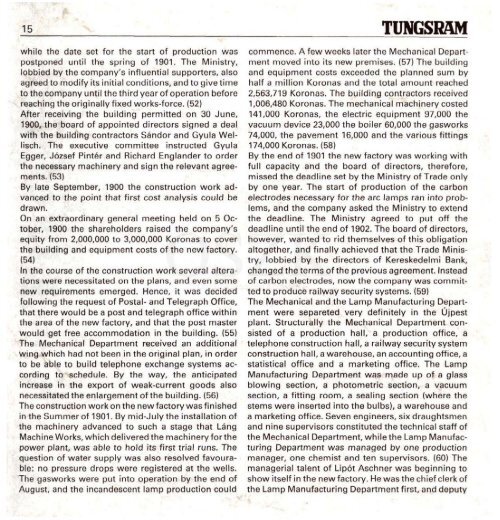THE HISTORY OF TUNGSRAM 1896-1945 - MEK
THE HISTORY OF TUNGSRAM 1896-1945 - MEK
THE HISTORY OF TUNGSRAM 1896-1945 - MEK
- No tags were found...
You also want an ePaper? Increase the reach of your titles
YUMPU automatically turns print PDFs into web optimized ePapers that Google loves.
15 <strong>TUNGSRAM</strong>while the date set for the start of production waspostponed until the spring of 1901. The Ministry,lobbied by the company's influential supporters, alsoagreed to nnodify its initial conditions, and to give timeto the company until the third year of operation beforereaching the originally fixed works-force. (52)After receiving the building permitted on 30 June,1900, the board of appointed directors signed a dealwith the building contractors Sandor and Gyula Wellisch.The executive committee instructed GyulaEgger, Jozsef Pinter and Richard Englander to orderthe necessary machinery and sign the relevant agreements.(53)By late September, 1900 the construction work advancedto the point that first cost analysis could bedrawn.On an extraordinary general meeting held on 5 October,1900 the shareholders raised the company'sequity from 2,000,000 to 3,000,000 Koronas to coverthe building and equipment costs of the new factory.(54)In the course of the construction work several alterationswere necessitated on the plans, and even somenew requirements emerged. Hence, it was decidedfollowing the request of Postal- and Telegraph Office,that there would be a post and telegraph office withinthe area of the new factory, and that the post masterwould get free accommodation in the building. (55)The Mechanical Department received an additionalwing which had not been in the original plan, in orderto be able to build telephone exchange systems accordingto schedule. By the way, the anticipatedincrease in the export of weak-current goods alsonecessitated the enlargement of the building. (56)The construction work on the new factory was finishedin the Summer of 1901. By mid-July the installation ofthe machinery advanced to such a stage that LangMachine Works, which delivered the machinery forthepower plant, was able to hold its first trial runs. Thequestion of water supply was also resolved favourable:no pressure drops were registered at the wells.The gasworks were put into operation by the end ofAugust, and the incandescent lamp production couldcommence. A few weeks later the Mechanical Departmentmoved into its new premises. (57) The buildingand equipment costs exceeded the planned sum byhalf a million Koronas and the total amount reached2,563,719 Koronas. The building contractors received1,006,480 Koronas. The mechanical machinery costed141,000 Koronas, the electric equipment 97,000 thevacuum device 23,000 the boiler 60,000 the gasworks74,000, the pavement 16,000 and the various fittings174,000 Koronas. (58)By the end of 1901 the new factory was working withfull capacity and the board of directors, therefore,missed the deadline set by the Ministry of Trade onlyby one year. The start of production of the carbonelectrodes necessary for the arc lamps ran into problems,and the company asked the Ministry to extendthe deadline. The Ministry agreed to put off thedeadline until the end of 1902. The board of directors,however, wanted to rid themselves of this obligationaltogether, and finally achieved that the Trade Ministry,lobbied by the directors of Kereskedelmi Bank,changed the terms of the previous agreement. Insteadof carbon electrodes, now the company was committedto produce railway security systems. (59) -The Mechanical and the Lamp Manufacturing Departmentwere separeted very definitely in the Ujpestplant. Structurally the Mechanical Department consistedof a production hall, a production office, atelephone construction hall, a railway security systemconstruction hall, a warehouse, an accounting office, astatistical office and a marketing office. The LampManufacturing Department was made up of a glassblowing section, a photometric section, a vacuumsection, a fitting room, a sealing section (where thestems were inserted into the bulbs), a warehouse anda marketing office. Seven engineers, six draughtsmenand nine supervisors constituted the technical staff ofthe Mechanical Department, while the Lamp ManufacturingDepartment was managed by one productionmanager, one chemist and ten supervisors. (60) Themanagerial talent of Lipot Aschner was beginning toshow itself in the new factory. He was the chief clerk ofthe Lamp Manufacturing Department first, and deputy








![Letöltés egy fájlban [4.3 MB - PDF]](https://img.yumpu.com/50159926/1/180x260/letaltacs-egy-fajlban-43-mb-pdf.jpg?quality=85)







